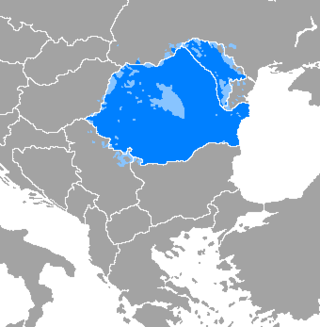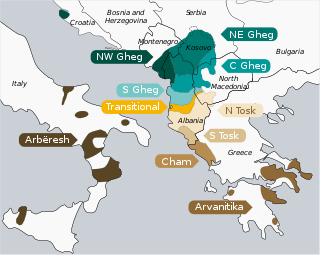Background

Romanian is a Romance language with about 25 million native speakers. [2] It is the official language of Romania and Moldova and has a co-official status in Vojvodina (in Serbia). [2] Ethnic Romanians also live in Ukraine [2] and Hungary. [3] Significant Romanian diasporas developed in other European countries (especially in Italy and Spain) and in North America, Australia and Israel. [2] Romanian is closely related to three other Eastern Romance languages, Aromanian, Megleno-Romanian and Istro-Romanian, all descending from a common Proto-Romanian language. [4] Romanian is divided into two main dialects, with a northern dialect spoken in Moldavia, northern Transylvania, Maramureș and Banat, and a southern dialect in Wallachia, but transitional variants also exist in Oltenia and Transylvania. [5]
The origin of the Romanians is still subject to scholarly debates. [6] [7] The core of the debate is the continuous presence of the Romanians in the lands now forming Romania north of the Lower Danube. [8] [9] Scholars who propose that the Roman province of Dacia Trajana (which existed to the north of the river for about 165 years) was an important venue of the Romanians' ethnogenesis accept the continuity north of the Danube, a theory also supported by scholars who consider that the origins of the Romanians included territories located not only in Dacia, but also in areas south of the Danube (which were under Roman rule for centuries). [7] [8] [10] Scholars who refute these theories propose that the ethnogenesis of the Romanians started in the south-Danubian provinces and the Romanians' ancestors did not settle in the lands to the north of the Lower Danube before the 11th century. [7] [11]
Romanian developed in territories which were isolated from other Romance languages for more than a thousand years. [12] [13] This geographic isolation gave rise to the development of a number of specific features. [12] For instance, palatalized dental consonants (especially "z") replaced the non-palatalized consonants in verbs. [12] The number of Romanian words directly inherited from Latin (about 1,550–2,000, depending on the source) is similar to the other Romance languages, [14] and is low in comparison with Medieval Greek (which contained about 3,000 Latin roots). [15] Romanian along with Spanish and Portuguese retained more archaic lexical items from Latin than other Romance languages, most probably due to their peripheral position. [15] For instance, the classical Latin word for beautiful (formosus) can still be detected in Romanian frumos, Portuguese formoso and Spanish hermoso, but it was replaced by terms deriving from another Latin word, bellus in French (beau) and Italian (bello). [16]
Romanian shares linguistic features with the non-Romance languages of the Balkan Peninsula, which gave rise to the idea of a "Balkan linguistic union". [11] [17] [18] There are some further common features of Albanian and Romanian. [19] [20] Scholars assume that Albanian was closely related to the likely Thracian [21] or Thraco-Dacian [22] substrate languages, whose Romanization gave rise to the development of Romanian, or descends from it. [22] Slavic languages influenced the development of Romanian for centuries. [11] [23] Romanian borrowed hundreds of words from Slavic languages and Slavic influence can be detected in Romanian phonology and morphology. [24] Romanians also adopted Old Church Slavonic as the language of liturgy together with the Cyrillic script. [25] In addition to Slavic influence Romanian borrowed words from other neighbouring languages such as Hungarian or Greek. The latter had a strong influence during the Phanariot era over Wallachia and Moldavia, with numerous words entering the southern sub-dialects. Of these only about 10% remained in usage from the 19th century onward, according to linguist László Gáldi. [26]
Flavio Biondo was the first scholar to have observed (in 1435) linguistic affinities between the Romanian and Italian languages, as well as their common Latin origin. [27] When comparing Romanian with other Romance languages, linguists noticed its peculiarities which can be detected at all linguistic levels. [28] Some scholars even believed that Romanian was a Slavic language. [29] In the early 19th century, the Slovene linguist, Jernej Kopitar, suggested that Romanian emerged through the relexification either of an ancient Balkan language or of a Slavic idiom, instead of directly developing from Vulgar Latin. [30] Paul Wexler published a similar hypothesis in 1997. [30] Linguist Anthony P. Grant writes that Wexler's hypothesis is not "completely convincing", stating that the "rise of Romanian still seems to be a case of language shift, analogous to the rise of English in England", with the Romanian's substratum equivalent to British Celtic, the Balkan Latin stratum similar to Anglo-Saxon, and the South Slavic superstratum equivalent to the Norman French role. [21] Linguist Posner attributed to Friedrich Diez, who was one of the first German scholars systematically studying Romance philology, the opinion of Romanian ("Wallachian") being a semi-Romance language in the early 19th century. [31] In his Grammar of the Romance Languages (1836) Diez retains six languages of the Romance area which attract attention, in terms of their grammatical or literary significance: Italian and Romanian, Spanish and Portuguese, Provençal and French. All six languages have their first and common source in Latin, a language which is 'still intertwined with our civilization'. [32] [33] Harald Haarmann considers that any discussion about the position of Romanian within the Romance philology was definitely decided with the Grammar of Diez. After the publication of his Grammar of the Romance Languages, Romanian is always listed among the Romance languages. [34] Schippel observes that since Friedrich Diez' Grammar, the Romance character of Romanian wasn't seriously doubted. [35] Werner Bahner concludes that “since the second half of the 19th century the Romance character of the Romanian has to be regarded as an absolutely certain knowledge” as „from the outset Romanian was considered a Romance language”. [36] As linguist Graham Mallinson emphasizes, "Romanian in its various forms retains enough of its Latin heritage at all linguistic levels to qualify for membership of the Romance family in its own right". [37]
The re-latinization evolved differently in the Romanian-populated areas. [38] In Wallachia and Moldavia from 1760 to 1820–1830 the lexical influence of French and New Greek was the most influential, while in the Banat and Transylvania the Romanian language adopted words mainly from Latin and German languages. [38] After 1830 the French language became the main source of the borrowings. [38]
When derivations of the Latin type-words are taken into account, research shows that “the proportion of the resulting group in the total vocabulary of Romanian remains, with nearly 80% of types-words in the dictionaries, about the same from the texts of 16/17th centuries to present Romanian”, [39] concluding that “the vocabulary of Old Romanian is as Romanic as the vocabulary of the modern Romanian language”. [39] [40]












